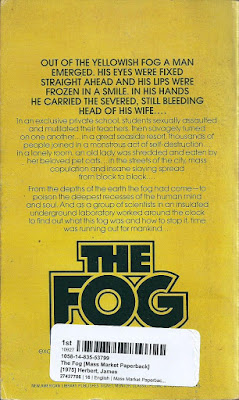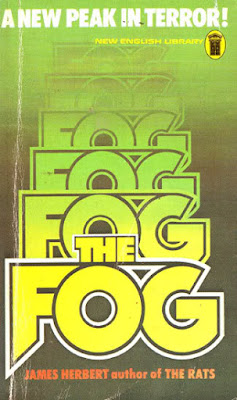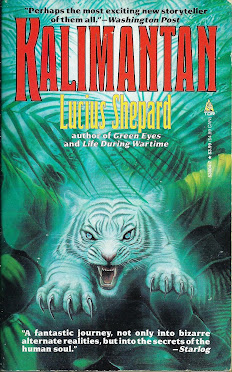Signet paperback, US, 1975
New English Library paperback, 1975, UK
un-used cover artwork by Tim White for the 1975 New English Library edition, UK
5 / 5 Stars
If you read horror fiction at all during the 70s, then it's highly likely that at some point during that time you encountered a James Herbert novel, and it's also likely that none grabbed your attention quite the way The Fog did.......
I remember being intrigued by the Signet paperback copy of this book (275 pp) when it first was published in December 1975.
I was then a sophomore in high school, and The Fog wound up being passed hand to hand among most of the kids in my class. It was like 'literary crack'.
The book's uncredited cover artist provided a masterpiece of lurid, eye-catching illustration........all you needed to see was the nude bodies smeared with blood, and the faces gleaming with Depraved Intent, to know that this was no 'traditional' 70s horror novel like The Other, Carrie, Julia, Burnt Offerings, or The Little Girl Who Lives Down the Lane. Mannered books, devoid of much in the way of explicit horror or violence.
The Fog, as is now quite clear, was - along with Herbert's 1974 novel The Rats - a primordial Splatterpunk novel. Even today, nearly 50 years later, both of Herbert's novels still retain their offbeat and provocative nature.
Steve Crisp's cover art for the 1988 New English Library edition, UK
I won't offer a full synopsis of The Fog, mainly because there are plenty of in-depth reviews available online.
I will say the plot is relatively straightforward: a freak earthquake takes place near a small village located close to the Salisbury Plain in southern Britain. A strange gas escapes from the newly opened fissure in the ground, and begins to spread over the countryside. All people and animals exposed to the Fog undergo a rapid loss of their inhibitions, and revert into a crazed fugue state, one that sees them overly prone to carry out violent acts with no hesitation or remorse.
John Holman, a square-jawed, no-nonsense Department of the Environment employee, has survived a firsthand encounter with the Fog, and quickly becomes the lead actor in the government's efforts to locate, and counter, the phenomenon.
But for Holman and the UK, time is running out. For the Fog is heading for London....... !
The main plot thread centers on the adventures of John Holman and his mission to defeat the Fog.
This is interspersed with vignettes gleefully depicting the various acts of mayhem and gory atrocities that the Fog-crazed denizens of the British countryside and city are wont to indulge in. Throughout his novel, Herbert relies on a detached prose style that lends itself well to recounting the increasingly gruesome toll taken by the psychotic victims of the Fog.
And, Herbert avoids the obvious cop-out in making the Fog an occult or supernatural menace; there is a sf subtext to the plot that, in my opinion, gives the book an edge over his related work, The Dark (1980). In this regard, The Fog acquires the sort of quasi-documentary style that is typified by Michael Crichton novels.
Summing up..........if you haven't read The Fog (or for that matter, The Rats) then it should be on your reading list.
It's by no means a triumph of 'literary achievement' (as such things might be counted), but it's a seminal novel in the birth of 'modern' horror.
Before there was Clive Barker, Tight Little Stitches in a Dead Man's Back, Book of the Dead, and Jerry's Kids Meet Wormboy - there was James Herbert and The Fog.

























































